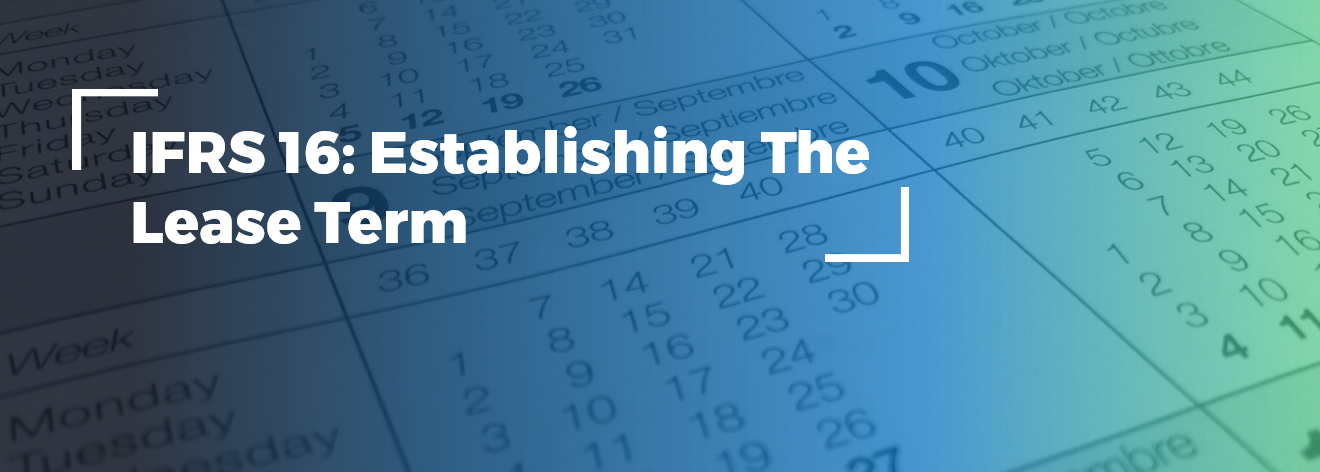IFRS 16 – Establishing The Lease Term
Updated 26th May 2021 | 7 min read Published 2nd January 2020

There are many hurdles, judgements and considerations in preparing a lease for compliance under the rules of IFRS 16.
One of these is the “lease term” which on the face of it might seem one of the easier ones when set alongside those such as:
- The appropriate discount rates
- Exemptions regarding short-term leases and low-value assets
- Applying IFRS 16 to intangible assets
- Separating non—lease components by class of asset
The calculation of the actual “lease term” however has a number of impacts which should be considered carefully and IFRS 16 gives a number of guidelines which should be adhered to:
- A short term may mean that the associated exemption is an option
- The longer the term then the longer the “right of use”
- The associated periodic liability will reflect the lease length
- Extension options must be considered
- Early termination options will need to be watertight to be relevant
The Lease Term
The lease term, under IFRS 16, is defined as “the non-cancellable period for which a lessee has the right to use an underlying asset, together with both: [IFRS 16:18]
- periods covered by an option to extend the lease if the lessee is reasonably certain to exercise that option; and
- periods covered by an option to terminate the lease if the lessee is reasonably certain not to exercise that option”.
While the concept of ‘reasonably certain’ has not changed from IAS 17, we expect this to be a challenging area and the application of this concept will require careful consideration of all the facts and circumstances that create a significant economic incentive for a lessee to extend the lease (where a lessee has an option to extend) or an incentive not to terminate a lease (where the lessee has an option to “early” terminate). This is a judgement which will reflect factors specific to the asset, the entity and the wider market.
When assessing whether a lessee is reasonably certain to exercise an option to extend the lease or not exercise an option to terminate the lease, the lessee considers all relevant facts and circumstances (both monetary and non-monetary) that create an economic incentive for them to exercise or not exercise that option. The assessment should include any expected changes in facts and circumstances from the commencement date until the exercise date of the option.
The factors that need to be considered, assessed and measured regarding lease termination or extension options include:
- The importance of the asset to the business operations of the lessee bearing in mind the availability of alternatives, its specialisation and location
- Any contracted conditions associated with exercising a termination
- Significant leasehold improvements undertaken (or expected to be undertaken) over the term of the contract that are expected to have significant economic benefit for the lessee when the option to extend or terminate the lease, or to purchase the underlying asset, becomes exercisable
- Costs of returning the asset and deploying another
- The value of termination “penalty” costs
- Are the options at market rates or substantially below them?
Lease Start Date
The lease term begins on the ‘commencement date’ of the lease. [IFRS 16: B36] This is defined as the date on which the lessor makes an underlying asset available for use by a lessee [IFRS 16: Appendix A]. It is the date on which the lessee initially recognises and measures right-of-use assets and lease liabilities and the date on which the lessor recognises assets held under a finance lease in its statement of financial position.
The assets, liabilities, income and expenses resulting from a lease are neither recognised in the financial statements nor measured until the actual commencement date (see IFRS 16: BC142 to BC144). Put simply, a lessee does not obtain and control its right to use the underlying asset until the commencement date. Before that date, the lessor has not performed under the contract and therefore the contract has not commenced. If a lessee has a lease payment obligation together with a right-of-use asset prior to the proposed commencement date, then IFRS 16: B44 explicitly requires that they be included with all other contracted lease payments. A lease term begins at the commencement date and includes any rent-free periods provided to the lessee by the lessor and that term will be.
When is a Lease Term Option not an Option?
IFRS 16 requires an entity to assess enforceability when considering the definition of a ‘contract’. A contract is defined as “an agreement between two or more parties that creates enforceable rights and obligations”. A lease cannot be enforceable if either the lessee or the lessor has the right to terminate the lease without permission from the other party with no more than just an insignificant penalty.
In order to be considered when assessing the lease term, options to extend or terminate the lease must be enforceable. Essentially it is only enforceable if a lessee is able to exercise its option to extend or terminate the lease and the lessor has no right to decline the request. If the lessor can decline a lessee’s request to extend or terminate the lease, then the lessee’s option is not enforceable and is ignored when assessing the lease term.
Summary
A contracted lease term begins at the commencement date, when right-of-use assets, liabilities, and expenses are recognised in the financial statements, and continues for the non-cancellable period of the contract. However, if at lease commencement, the lessee is deemed reasonably certain to extend and that option is exercisable unilaterally, then the lease extension period is considered part of the contracted term. Similarly, the contracted lease term can be “adjusted” from a financial recognition stance by considering any reasonably certain, enforceable early termination options. If at any time the lease term is extended or curtailed then the financial calculations and measurements must all be back accounted for from the commencement date to the revised termination date and yet again if it is further extended - it is, therefore, worth getting that lease term right in the first place or you’ll be posting journals and in extreme cases restating financial performance forever.
In summary, remember that the lease term is revised during the term of the lease from a financial position if there is a change to the non-cancellable period of the lease such as when
- the lessee exercises an option which was not previously incorporated into the lease term, an option that was deemed unlikely to be exercised at commencement date
- the lessee does not exercise an option which was previously included in the lease term, an option that was previously deemed likely to be exercised at commencement date
- an event occurs resulting in a contractual obligation for the lessee to exercise an option not previously included in the lease term
- an event occurs that contractually prohibits the lessee from exercising an option previously included in the lease term.
The lessee will need to account for these events by restating the lease liability, by including the lease payments over the revised term, by applying a revised discount rate (the interest rate implicit in the lease for its remaining term if readily determinable, or the lessee’s incremental borrowing rate at the date of reassessment if not) and by making a corresponding adjustment to the right-of-use asset.
There are lease management and accounting solutions that ease this work – not just during the transition to IFRS 16 but afterwards in remaining compliant. LOIS Lease Accounting from Innervision is one such solution that among other things will in the event of restating the lease term, recalculate depreciation, adjust the right-of-use asset, account for the expected and received payments and finally generate and post the necessary GL journals.
For more guidance and information on how lease accounting software can help both during and post transition click on the link to the LLA brochure below.
Disclaimer: this article contains general information about the new lease accounting standards only and should NOT be viewed in any way as professional advice or service. The Publisher will not be responsible for any losses or damages of any kind incurred by the reader whether directly or indirectly arising from the use of the information found within this article.







